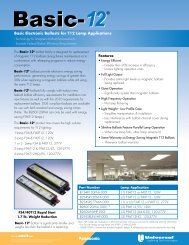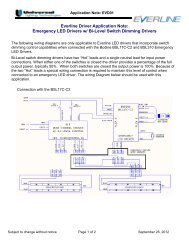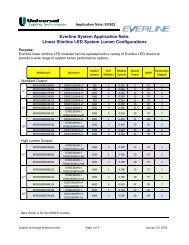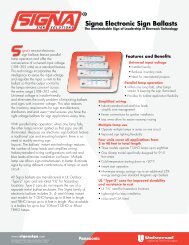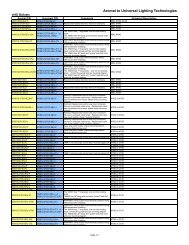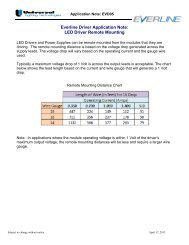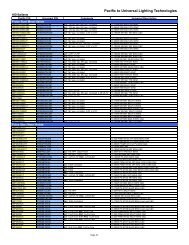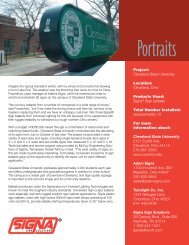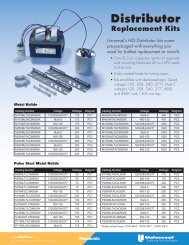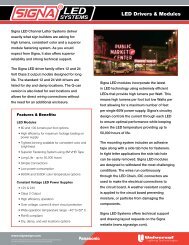SuperDim® Analog Dimming - Universal Lighting Technologies
SuperDim® Analog Dimming - Universal Lighting Technologies
SuperDim® Analog Dimming - Universal Lighting Technologies
You also want an ePaper? Increase the reach of your titles
YUMPU automatically turns print PDFs into web optimized ePapers that Google loves.
SuperDim ® Troubleshooting Guidelines<br />
SuperDim Troubleshooting Guidelines<br />
Note: All wiring must be completed in compliance with national and local electrical codes.<br />
Note: All wiring must be completed in compliance with national and local electrical codes.<br />
Caution!! Disconnect power before servicing ballasts, fixtures or other system components.<br />
Caution!! Disconnect power before servicing ballasts, fixtures or other system components.<br />
Symptom Possible Reason Action<br />
Ballast not powered.<br />
Ballast not properly grounded.<br />
Check power wiring, luminaire disconnect, circuit breaker, etc.<br />
Fixture must be properly grounded, and ballast housing must have good electrical contact with metallic fixture<br />
chassis. Use of a star washer or other paint penetrating device is recommended for ballast mounting. Some<br />
ballasts provide a ground terminal as an alternative means to make this connection.<br />
Lamps never turn ON, or lamps flash<br />
and then turn OFF<br />
Incorrect lamps.<br />
Ensure lamp selection matches ballast capabilities.<br />
Lamp-ballast wiring error.<br />
Ensure connections between ballast and lamps are exactly as shown on ballast label.<br />
Shunted sockets. SuperDim ballasts require non-shunted Inspect or test lamp holders (sockets). With lamp removed and ballast disconnected, a shunted socket will<br />
sockets, also known as rapid-start or program-start always present a short circuit (zero ohms) between connections. Non-shunted sockets do not provide a<br />
sockets.<br />
connection (internal or external) between the blades.<br />
Poor starting aid.<br />
(not applicable to CFL models)<br />
Defective lamps.<br />
Defective ballast.<br />
Ensure that a grounded metallic surface is within proper distance of the lamps. Spacing between the lamp wall<br />
and the grounded metallic surface should be between 0.125 and 0.500 in. for the entire length of the<br />
fluorescent tube. This requirement applies to linear fluorescents only.<br />
Try lamp replacement.<br />
Try ballast replacement.<br />
Some or all fixtures stuck at minimum<br />
intensity<br />
Control wires at line potential.<br />
Controller not powered.<br />
Short circuit between control wires.<br />
Wrong polarity at one or more control circuit connection<br />
points.<br />
Carefully inspect all connections. Control circuit must not be connected to power conductors.<br />
When unpowered, some controllers may force the control voltage to a low level resulting in minimum intensity<br />
operation. Check line, neutral and ground connections.<br />
Inspect control wiring for improper connections or damage resulting in a short-circuit condition.<br />
Inspect control wiring. Sound connections, and correct polarity must be maintained throughout the control<br />
circuit: purple-to-purple and gray-to-gray.<br />
Some or all fixtures stuck at maximum<br />
intensity<br />
Ballasts do not respond to controller<br />
Control wires disconnected.<br />
Wrong controller type.<br />
Controller not powered.<br />
Control wires disconnected.<br />
Short circuit between control wires.<br />
Wrong polarity at one or more control circuit connection<br />
points.<br />
Inspect control wiring for improper connections or damage resulting in an open-circuit condition.<br />
Check control specification. Use only 0-10V control. Please see the controls compatibility chart on the<br />
SuperDim webpage for some typical examples of suitable 0-10V controls.<br />
Check line, neutral and ground connections.<br />
Inspect control wiring for improper connections or damage resulting in an open-circuit condition.<br />
Inspect control wiring for improper connections or damage resulting in a short-circuit condition.<br />
Inspect control wiring. Sound connections, and correct polarity must be maintained throughout the control<br />
circuit: purple-to-purple and gray-to-gray.<br />
Lamps flicker or strobe<br />
Lamp-ballast wiring error.<br />
Ensure connections between ballast and lamps are exactly as shown on ballast label.<br />
Shunted sockets. SuperDim ballasts require non-shunted Inspect or test lamp holders (sockets). With lamp removed and ballast disconnected, a shunted socket will<br />
sockets, also known as rapid-start or program-start always present a short circuit (zero ohms) between connections. Non-shunted sockets do not provide a<br />
sockets.<br />
connection (internal or external) between the blades.<br />
Poor starting aid.<br />
(not applicable to CFL models)<br />
Incorrect lamps.<br />
Excessive lead lengths.<br />
Ballast not properly grounded.<br />
Ensure that a grounded metallic surface is within proper distance of the lamps. Spacing between the lamp wall<br />
and the grounded metallic surface should be between 0.125 and 0.500 in. for the entire length of the<br />
fluorescent tube. This requirement applies to linear fluorescents only.<br />
Ensure lamp selection matches ballast capabilities.<br />
Lamp leads must not exceed their specified lengths and, when practical, excess length should be removed.<br />
Lamp leads should not be bunched, bundled or tightly dressed by wire ties or other means.<br />
Fixture must be properly grounded, and ballast housing must have good electrical contact with metallic fixture<br />
chassis. Use of a star washer or other paint penetrating device is recommended for ballast mounting. Some<br />
ballasts provide a ground terminal as an alternative means to make this connection.<br />
Cold lamps<br />
New lamps<br />
Ensure ambient temperature meets or exceeds the ballast's minimum starting temperature and is also suitable<br />
for the selected lamps.<br />
Some lamp manufacturers recommend burning lamps at full intensity for at least 12 hours before dimming.<br />
Loose connection.<br />
Ballast not properly grounded.<br />
Check power wiring, luminaire disconnect, circuit breaker, etc.<br />
Check control circuit for intermittent connections.<br />
Fixture must be properly grounded, and ballast housing must have good electrical contact with metallic fixture<br />
chassis. Use of a star washer or other paint penetrating device is recommended for ballast mounting. Some<br />
ballasts provide a ground terminal as an alternative means to make this connection.<br />
Intermittent or unpredictable operation Shunted sockets. SuperDim ballasts require non-shunted Inspect or test lamp holders (sockets). With lamp removed and ballast disconnected, a shunted socket will<br />
sockets, also known as rapid-start or program-start always present a short circuit (zero ohms) between connections. Non-shunted sockets do not provide a<br />
sockets.<br />
connection (internal or external) between the blades.<br />
Lamps ends turn black and/or frequent<br />
lamp failures<br />
Poor starting aid.<br />
(not applicable to CFL models)<br />
Shunted sockets. SuperDim ballasts require non-shunted<br />
sockets, also known as rapid-start or program-start<br />
sockets.<br />
Lamp-ballast wiring error.<br />
Incorrect lamps.<br />
Ensure that a grounded metallic surface is within proper distance of the lamps. Spacing between the lamp wall<br />
and the grounded metallic surface should be between 0.125 and 0.500 in. for the entire length of the<br />
fluorescent tube. This requirement applies to linear fluorescents only.<br />
Inspect or test lamp holders (sockets). With lamp removed and ballast disconnected, a shunted socket will<br />
always present a short circuit (zero ohms) between connections. Non-shunted sockets do not provide a<br />
connection (internal or external) between the blades.<br />
Ensure connections between ballast and lamps are exactly as shown on ballast label.<br />
Ensure lamp selection matches ballast capabilities.<br />
Additional Troubleshooting Techniques<br />
In some cases, the troubleshooting methods outlined above may not lead to a quick detection and resolution of the problem. In this case, it is often beneficial to perform one or more of the following methods.<br />
Method<br />
System division<br />
Bypass installed control wires and do<br />
step-wise system reconstruction<br />
Explanation<br />
When a large system of SuperDim ballasts has an apparent malfunction, but the specific component or location of the malfunctions is unknown, the system can be divided<br />
near the center of the control circuit. If the malfunction persists on one side, but not the other, the scope of the troubleshooting effort is reduced. Further separations may<br />
be used, of course, to help find the actual trouble site.<br />
When the cause of a malfunction cannot be assigned to a ballast or to the control wires, ballasts can be individually tested using a known good controller connected by<br />
external control wires. The system can then be reconstructed in steps, using only a few ballasts and short sections of the installed control wiring at one time. If a problem<br />
is encountered during this process, the cause can often be attributed to the ballast or control wires added in the last step.<br />
6



